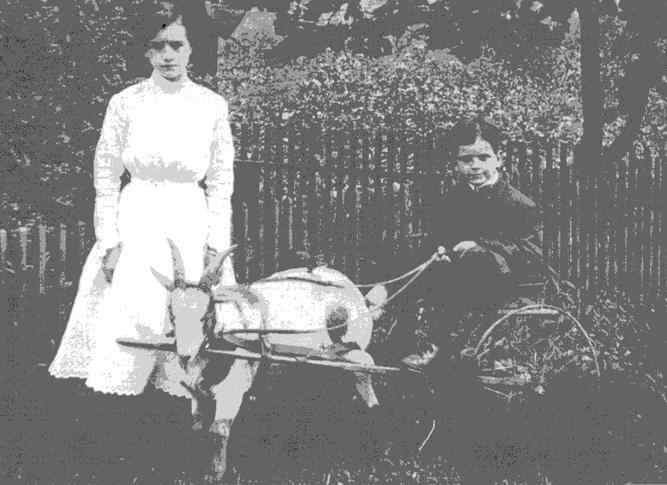
Outdoor Play and Games: Carts--Animal Propulsion

Figure 1.--Here we see the Roberts' children in America during 1910. The boy wears a dark sailor suit and has a great goat cart. This charming snapshot was taken in 1910 in Bloomington, Indiana. The two children are Thena and Tom Roberts, the children of Thomas Jefferson Roberts, a local blacksmith. He was fairly prominent and had one of the major businesses in Bloomington in 1910. The girl is about 16; the boy seems to be about 6 years old. She, although not quite an adult yet, wears a longish white dress that comes down to just above her ankles. Her brother wears a rather stylish knee pants suit with long black stockings and low-cut shoes. Notice the large bow tie and the neatly parted hair.
|
|
We see mumerous images of children enjoying carts pulled by animals. The children seem to enjoy them. Very young children were just passengers. Older children would actually drive them. They seem particularly prevalent in the late-19th and early-20th century. They may have been popular earlier in the 19th century, but we have no photographic evidence. After the early-20th century as automobiles became more common we see fewer examples. Propulsion for childens' carts varied. Richer children might have a pony cart. Affluent children might have a goat or dog cart. Because they were commonly pulled by goats, they were often called billycarts. We note rural images, here there was a wider social class pattern as animals were more common in the countryside. We have noted these carts in America, Britain, and Germany, but suspect they were also found in other countries as well. They were quite popular and as goats never pulled them at any speed, were safe even for younger children. The pony carts required a little more supervision. The childrn who had pony carts almost by definition were well to do, or lived in rural areas. Children with pony carts might live on estates.
Prevalence
We see mumerous images of children enjoying carts pulled by animals. The number of images is a good indicator of prevalence.
Popularity
The children seem to enjoy them. Both the animals and moving around on their own is what made it a popular activity. The ability to move is the same characteristic that made peddal cars and trikes popular with more modrn children.
Ages
Very young children were just passengers. An adult or older child would lead the animal pulling the child. Older children would actually drive them. They were quite popular and as goats never pulled them at any speed, were safe even for younger children.
Chronology
These animal pulled carts seem particularly prevalent in the late-19th and early-20th century. They may have been popular eralier in the 19th century, but we have no photographic evidence. After the early-20th century as automobiles became more common we see fewer examples. And we beh\gin to see cart being replaced with pedal cars, trikes, and waggons which made the fun more accessible to urban children.
Propulsion for childens' carts varied. Richer children might have a pony cart. Affluent children might have a goat or dog cart. We have found more images of goats pulling these carts than nany other animal. This is because a goat was strong enough to pull a light-weight cart with small children, but not pull it very fast so they were safe. And they were a coomon, low-maintenance farm animal. The goats were gentle animals and safe. Because they were commonly pulled by goats, they were often called billycarts. Pony carts were for older children and required more supervision. The children who had pony carts almost by definition were well to do and lived on rural estates of one kind or another. Children with pony carts might live on estates.
Demographics
The images we have found are farm, small-town, and the estates of ealthy individuals. We note rural images, here there was a wider social class pattern as animals were more common in the countryside. They are not very common in the city, primarily because of the complications of keeping animals.
Social Class
Many of the images we have dound suggest that the children's carts were mostly enjoyed by the wealthy. Often wealthy families who had rural estates. This was not always the case. Here we see an American boy whose father was a blacksmith with a goat cart (figure 1). We tend to see more of these images where the family was not rich from America. We suspect this reflects the fact that America was a more wealthy country as well as the larger photographic recoord in America.
Countries
We have noted these carts in America, Britain, and Germany, but suspect they were also found in other countries as well. These countries were among the most affluent. And thus had the largest photographic record. Other actors may be involved.
HBC

Navigate the Boys' Historical Clothing Web Site:
[Return to the Main cart page activities vehicle page]
[Introduction]
[Activities]
[Biographies]
[Chronology]
[Cloth and textiles]
[Clothing styles]
[Countries]
[Topics]
[Bibliographies]
[Contributions]
[FAQs]
[Glossaries]
[Images]
[Satellite sites]
[Tools]
[Boys' Clothing Home]
Navigate the Boys' Historical Clothing Web Site:
[Sailor hats]
[Sailor suits]
[Buster Brown suits]
[Eton suits]
[Rompers]
[Tunics]
[Smocks]
[Pinafores]
Created: 4:42 PM 4/6/2019
Last updated: 4:42 PM 4/6/2019



